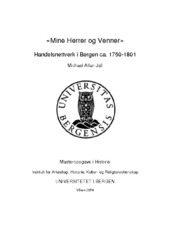| dc.contributor.author | Jall, Michael Allan | |
| dc.date.accessioned | 2016-06-14T05:42:23Z | |
| dc.date.available | 2016-06-14T05:42:23Z | |
| dc.date.issued | 2016-05-18 | |
| dc.date.submitted | 2016-05-18 | eng |
| dc.identifier.uri | https://hdl.handle.net/1956/12101 | |
| dc.description.abstract | For å være en vellykket kjøpmann i tidlig moderne Europa måtte en kunne disponere et nettverk av kunder og leverandører. Denne oppgaven vil vise hvordan to handelshus i siste halvdelen av 1700-tallet i Bergen brukte sine respektive nettverk til å ble noen av mest vellykkede og rikeste kjøpmennene i byen. Bergen hadde i flere århundrer vært koblet sammen med et internasjonalt handelsnettverk med hanseatiske byer takket være byens status som mellommann for salg av fisk fra Nord-Norge. Men etter lengre tid med forvitring stengte det hanseatiske Kontor i 1754 på grunn av at handelen i større grad var i byens handelsborgerskaps hender. Samme år ble det Norske Kontor stiftet av tidligere hanseater og lokale kjøpmenn, og gamle hanseatiske metoder og det gamle kontorets organiseringsform ble ivaretatt. Hildebrand Harmens og Herman D. Janson var to kjøpmenn som tok forskjellige stier for å etablere seg i utenlandshandelen. Harmens var sønnen til en tysk innvandrer som etablerte seg etter å ha gått i lære under Kontoret. Gjennom hans eget arbeid og ved å kjøpe andre kjøpmenns forretninger utvidet gradvis Harmens sitt handelsnettverk. Janson var sønn av en nederlandsk innvandrer, og var utdannet som skipskaptein. Som kaptein jobbet han blant annet for den betydelige kjøpmannen Danckert D. Krohn. Krohn likte den unge kapteinen, og ville at han skulle gifte seg med broren Wollert Krohns eneste datter. Når Jansons nye familie overlot ham deler av deres forretninger etablerte Jansons seg i utenlandshandelen med et nettverk av kontakter og infrastrukturen til et handelshus allerede på plass. Fra både Harmens og Janson er det bevart kopibøker der alle deres utgående brev til kontakter over hele Europa er lagret. Ved hjelp av vennskap, kjøp av andre kjøpmenns bedrifter og en pragmatisk bruk av familie kunne de to kjøpmennene ekspandere sine handelshus selv i en tid preget av konstant urolighet i store deler av Europa. | en_US |
| dc.description.abstract | To be a successful merchant in the early modern Europe one had to rely on a network of contacts, both as customers and suppliers. This thesis will show how two traders in late 18th century Bergen used their respective networks to become some of the richest and most successful merchants in the city in this period. The city of Bergen had for centuries been connected to a trade network of hanseatic cities thanks to the city's connection with dry-fish supplied from the northern parts of Norway. But after a period of decline the hanseatic Kontor in Bergen was closed in 1754 after a period where more and more of the city's trade were in the hands of its own people. In its wake a new Kontor was established by former hansa-merchants and local Norwegian merchants, and the former hanseatic techniques and methods were kept alive. Hildebrand Harmens and Herman D. Janson were two merchants who took different paths in establishing their respective businesses. Harmens was the son of a German immigrant who established himself by going through an apprenticeship at the Kontor. Through his own work and purchasing other merchant's businesses Harmens gradually expanded his trade and his network of contacts. Janson, the son of a Dutch immigrant, was educated as a ship captain, and worked for the prominent merchant, agent and ship-owner Danckert D. Krohn. Krohn took a liking to the young captain and wanted him married to his brother Wollert's only daughter. When his new family left him parts of their trade businesses Janson established his own business with a network of contacts and an infrastructure for successful trade already in place. From both Harmens and Janson remains archives of the outgoing letters sent to their trade contacts and partners throughout Europe, through which we can understand what their network connections were based on. These letterbooks form the basis of this thesis. From friendships, purchases of other merchants' businesses and a pragmatic use of familial connections the two merchants were able to expand and grow their business of foreign trade, even in an era of war almost constantly affecting large parts of Europe, until the wars on the continent also spread to Denmark-Norway. | en_US |
| dc.format.extent | 1156471 bytes | eng |
| dc.format.mimetype | application/pdf | eng |
| dc.language.iso | nob | eng |
| dc.publisher | The University of Bergen | eng |
| dc.subject | Handelsnettverk | eng |
| dc.subject | Handel | eng |
| dc.subject | Nettverk | eng |
| dc.subject | Bergen | eng |
| dc.subject | 1700-tallet | eng |
| dc.subject | Hildebrand Harmens | eng |
| dc.subject | Herman D. Janson | eng |
| dc.title | Mine Herrer og Venner. Handelsnettverk i Bergen ca. 1750-1801 | eng |
| dc.type | Master thesis | |
| dc.rights.holder | Copyright the author. All rights reserved | eng |
| dc.description.degree | Master i Historie | |
| dc.description.localcode | MAHF-HIS | |
| dc.description.localcode | HIS350 | |
| dc.subject.nus | 713107 | eng |
| fs.subjectcode | HIS350 | |
